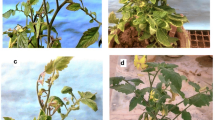Summary
Symptom development in tomato plants following whitefly-mediated inoculation with tomato yellow leaf curl virus (TYLCV) was related to the occurrence of viral DNA using a specific DNA probe. Although disease symptoms were first observed 15 days post-inoculation, viral DNA could be detected 7 days earlier. TYLCV-DNA concentrations reached an optimum 4 days before symptoms appeared. The highest concentrations of TYLCV-DNA were found in rapidly growing tissues (shoot apex, young leaves, roots) and in the stems; the lowest concentrations were found in the older leaves and cotyledons. Plants were also inoculated on specific sites. Young leaves and apices were the best targets for virus inoculation. In these tissues, the viral DNA replicated at the site of inoculation and was transported first to the roots, then to the shoot apex and to the neighboring leaves and the flowers. Inoculation through the oldest leaves was inefficient.
Similar content being viewed by others
References
Al-Musa A (1982) Incidence, economic importance, and control of tomato yellow leaf curl in Jordan. Plant Dis 66: 561–563
Atabekov JG, Dorokhov YL (1984) Plant virus-specific transport function and resistance of plants to viruses. Adv Virus Res 29: 313–364
Brough CL, Hayes RJ, Morgan AJ, Coutts RHA, Buck KW (1988) Effects of mutagenesis on the ability of cloned tomato golden mosaic virus DNA to infectNicotiana benthamiana plants. J Gen Virol 69: 503–514
Cherif C, Russo M (1983) Cytological evidence of the association of a geminivirus with the tomato yellow leaf curl disease in Tunisia. Phytopathol Z 108: 221–225
Cohen S, Harpaz I (1964) Periodic, rather than continual acquisition of a new tomato virus by its vector, the tobacco whitefly (Bemisia tabaci Gennadus). Entomol Exp Appl 7: 155–166
Cohen S, Kern J, Harpaz I, Ben-Joseph R (1988) Epidemiological studies of the tomato yellow leaf curl virus (TYLCV) in the Jordan Valley, Israel. Phytoparasitica 16: 259–270
Cohen S, Nitzany FE (1966) Transmission and host range of the tomato yellow leaf curl virus. Phytopathology 56: 1127–1131
Czosnek H, Ber R, Antignus Y, Cohen S, Zamir D (1988) Isolation of tomato yellow leaf curl virus, a geminivirus. Phytopathology 78: 508–512
Czosnek H, Ber R, Navot N, Zamir D, Antignus Y, Cohen S (1988) Detection of tomato yellow leaf curl virus in lysates of plants and insects by hybridization with a viral DNA probe. Plant Dis 72: 949–951
Czosnek H, Ber R, Navot N, Antignus Y, Cohen S, Zamir D (1989) Tomato yellow leaf curl virus DNA forms in the viral capside, in infected plants and in the insect vector. J Phytopathology 125: 47–54
Fargette D, Thouvenel J-C, Fauquet C (1987) Virus content of leaves of cassava infected by African cassava mosaic virus. Ann Appl Biol 110: 65–73
Hassan AA, Mazayad HM, Moustafa SE, Nassar SH, Nakhla MK, Sims WL (1984) Inheritance of resistance to tomato yellow leaf curl virus derived fromLycopersicon cheesmanii andLycopersicon hirsutum. Hort Sci 19: 574–575
Ho LC, Hewitt JD (1987) Fruit development. In: Atherton JG, Rudich J (eds) The tomato crop, a scientific basis for improvement. Chapman and Hall, New York, pp 201–239
Kasrawi MA, Suwwan MA, Mansour A (1988) Sources of resistance to tomato-yellow-leaf-curl-virus (TYLCV) inLycopersicon species. Euphytica 37: 61–64
Makkouk KM, Laterrot H (1983) Epidemiology and control of tomato yellow leaf curl virus. In: Plumb RT, Thresh JM (eds) Plant virus epidemiology. Blackwell, Oxford, pp 315–321
Maniatis T, Fritsch EF, Sambrook J (1982) Molecular cloning, a laboratory manual. Cold Spring Harbor Laboratories, Cold Spring Harbor
Matthews REF (1981) Plant virology. Academic Press, New York
Maule AJ, Harker CL, Wilson IG (1989) The pattern of accumulation of cauliflower mosaic virus-specific products in infected turnips. Virology 169: 436–446
Mazyad HM, Omar F, Al-Taher K, Salha M (1979) Observations on the epidemiology of tomato yellow leaf curl disease on tomato plants. Plant Dis Reporter 63: 695–698
Meshi T, Okada Y (1987) Systemic movement of viruses. In: Kosuge T, Nester EW (eds) Plant-microbe interactions, molecular and genetic perspectives. Macmillan, New York, pp 285–304
Navot N, Ber R, Czosnek H (1989) Rapid detection of tomato yellow leaf curl virus in squashes of plants and insect vectors. Phytopathology 79: 562–568
Pilowsky M, Cohen S (1974) Inheritance of resistance to tomato yellow leaf curl virus in tomatoes. Phytopathology 64: 632–635
Russo M, Cohen S, Martelli GP (1980) Virus-like particles in tomato plants affected by the yellow leaf curl disease. J Gen Virol 49: 209–213
Samuel G (1934) The movement of tobacco mosaic virus within the plant. Ann Appl Biol 21: 90–111
Zaitlin M, Hull R (1987) Plant virus-host interactions. Annu Rev Plant Physiol 38: 291–315
Author information
Authors and Affiliations
Rights and permissions
About this article
Cite this article
Ber, R., Navot, N., Zamir, D. et al. Infection of tomato by the tomato yellow leaf curl virus: susceptibility to infection, symptom development, and accumulation of viral DNA. Archives of Virology 112, 169–180 (1990). https://doi.org/10.1007/BF01323162
Received:
Accepted:
Issue Date:
DOI: https://doi.org/10.1007/BF01323162




